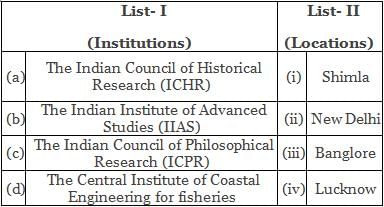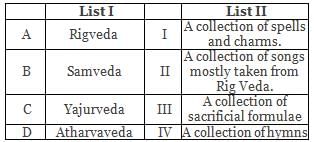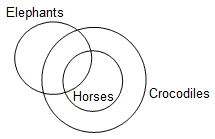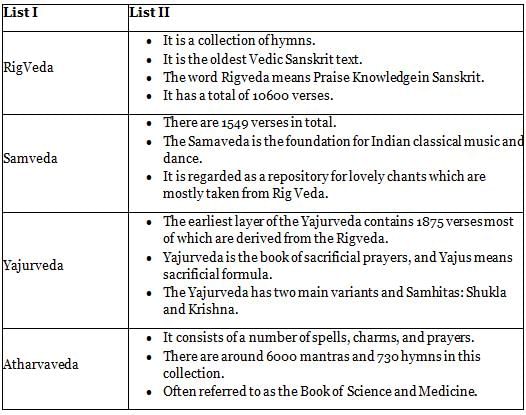Kerala SET Paper 1 Mock Test - 2 - KTET MCQ
30 Questions MCQ Test Kerala SET Mock Test Series 2025 - Kerala SET Paper 1 Mock Test - 2
Rich households in urban areas avail cheap credit from
Which of the following is grown in the rainy season?
Match List - I with List-II and select the correct answer from the code given below:

Which of the following sets of elements do not belong to the same group ?
Assertion: Airway is an important means of transport in the Northeastern part of India.
Reason: Northeastern India has difficult terrains and inaccessible areas.
Under the Air Quality Index in India, which of the following pollutants is not included?
Rohit is an above average intelligence student. He has always been praised by his teachers for his academic progress in the class. But, recently his achievement was not up to satisfaction. Which of the following could be a reason for his poor performance?
‘Information overload’ can be categorized as a ______ barrier to communication.
Directions: Read the following passage carefully and answer the given question.
The catalytic fact of the twentieth century is uncontrollable development, consumerist society, political materialism, and spiritual devaluation. This inordinate development has led to the transcendental ‘second reality’ of sacred perception that biologically transcendence is a part of human life. As the century closes, it dawns with imperative vigour that the ‘first reality’ of enlightened rationalism and the ‘second reality’ of the beyond have to be harmonised in a worthy state of man. The defacto values describe what we are, they portray the ‘is’ of our ethic, they are est values (Latin est means is). The ideal values tell us what we ought to be, they are esto values (Latin esto ‘ought to be’). Both have to be in the ebb and flow of consciousness. The ever new science and technology and the ever-perennial faith are two modes of one certainty, that is the wholeness of man, his courage to be, his share in Being.
The materialistic foundations of science have crumbled down. Science itself has proved that matter is energy, processes are as valid as facts, and affirmed the non-materiality of the universe. The encounter of the ‘two cultures’, the scientific and the humane, will restore the normal vision, and will be the bedrock of a ‘science of understanding’ in the new century. It will give new meaning to the ancient perception that quantity (measure) and quality (value) coexist at the root of nature. Human endeavours cannot afford to be humanistically irresponsible.
Q. The 'de facto' values in the passage mean
What among the following is the major factor of biodiversity change?
The most important of the privileges enjoyed by the clergy and nobility:
‘Fly ash’ produced in thermal power plants is an eco-friendly resource for use in:
1) agriculture as micro-nutrient
2) wasteland development
3) dam and water holding structures
4) brick industry
Choose the correct answer from the code given below:
Direction: The following consists of a question and two statements numbered I and II given below it. You have to decide whether the data provided in the statements are sufficient to answer the question.
What is Rohit's rank in the class?
Statement I. Rohit's rank is 24 less than Nandani's rank.
Statement II. Archana's rank is 38 more than Rohit's rank. Nandani's rank is 10 less than Archana's rank.
Which of the following communications has an emotional appeal?
Direction: If a Paper (Transparent Sheet) is folded in a manner and a design or pattern is drawn. When unfolded this paper appears as given below in the answer figure. Choose the correct answer figure given below.
Find out from the four alternatives as how the pattern would appear when the transparent sheet is folded at the dotted line.
Question Figure

Answer figure

Which of the following country share a land boundary with India in the north?
Under GATS, higher education policies are to be framed by which of the following Departments?
In which South Asian country is dictatorship preferred over democracy ?
McGrath earned a profit of Rs. 300 by selling 100 kg of a mixture of A and B types of rice at a total price of Rs. 1,100. What was the proportion of A and B types of rice in the mixture if the cost prices of A and B are Rs. 10 and Rs. 5 per kg, respectively?
In this questions, a number series is given with one term missing. Choose the correct alternative that will continue the same pattern and fill in the black spaces.
Q. 1, 4, 9, 16, 25, (____)
Directions: Read the following passage carefully and answer the following question.
All historians are interpreters of text if they be private letters, Government records or parish birthlists or whatever. For most kinds of historians, these are only the necessary means to understanding something other than the texts themselves, such as a political action or a historical trend, whereas for the intellectual historian, a full understanding of his chosen texts is itself the aim of his enquiries. Of course, the intellectual history is particularly prone to draw on the focus of other disciplines that are habitually interpreting texts for purposes of their own, probing the reasoning that ostensibly connects premises and conclusions. Furthermore, the boundaries with adjacent subdisciplines are shifting and indistinct, the history of art and science both claim a certain autonomy, partly just because they require specialised technical skills. Both can also be seen as part of a wider intellectual history, as is evident when one considers. For example, the common stock of knowledge about cosmological beliefs or moral ideals of a period.
Like all historians, the intellectual historian is a consumer rather than a producer of ‘methods’. His distinctiveness lies in which aspect of the past he is trying to illuminate, not in having exclusive possession of either a corpus of evidence or a body of techniques. That being said, it does seem that the label ‘intellectual history’ attracts a disproportionate share of misunderstanding.
It is alleged that intellectual history is the history of something that never really mattered. The long dominance of the historical profession by political historians bred a kind of philistinism, an unspoken belief that power and its exercise was ‘what mattered’. The prejudice was reinforced by the assertion that political action was never really the outcome of principles or ideas that were ‘more flapdoodle’. The legacy of this precept is still discernible in the tendency to require ideas to have ‘licensed’ the political class before they can be deemed worthy of intellectual attention, as if there were some reasons why the history of art or science, of philosophy or literature, were somehow of interest and significance than the history of Parties or Parliaments. Perhaps in recent years, the mirror-image of this philistinism has been more common in the claim that ideas of any one systematic expression or sophistication do not matter, as if they were only held by a minority.
Q. What is philistinism?
Directions: In the following question, there are two statements followed by two conclusions I and II. You are to take the two statements to be true even if they seem to be at variance from the commonly known facts and then decide which of the conclusions logically follow(s) from the two statements.
Statements:
Some elephants are horses.
All horses are crocodiles.
Conclusions:
I. No crocodile is an elephant.
II. Some elephants are crocodiles.
The MHRD, Government of India, initiative "e-ShodhSindhu" provides students and researchers access to
Which of the following decisions can be taken by the President on his own?
Directions: Read the given passage carefully and answer the following question:
Heritage conservation practices improved worldwide after the International Centre for the Study of the Preservation and Restoration of Cultural Property (ICCROM) was established with UNESCO’s assistance in 1959. The inter-governmental organisation with 126 member states has done a commendable job by training more than 4,000 professionals, providing practice standards, and sharing technical expertise. In this golden jubilee year, as we acknowledge its key role in global conservation, an assessment of international practices would be meaningful to the Indian conservation movement. Consistent investment, rigorous attention, and dedicated research and dissemination are some of the positive lessons to imbibe. Countries such as Italy have demonstrated that prioritising heritage with significant budget provision pays. On the other hand, India, which is no less endowed in terms of cultural capital, has a long way to go. Surveys indicate that in addition to the 6,600 protected monuments, there are over 60,000 equally valuable heritage structures that await attention. Besides the small group in the service of Archaeological Survey of India, there are only about 150 trained conservation professionals. In order to overcome this severe shortage, the emphasis has been on setting up dedicated labs and training institutions. It would make much better sense for conservation to be made part of mainstream research and engineering institutes, as has been done in Europe.
Increasing funding and building institutions are the relatively easy part. The real challenge is to redefine international approaches to address local contexts. Conservation cannot limit itself to enhancing the art-historical value of the heritage structures, which international charters perhaps overemphasise. The effort has to be broad-based: It must also serve as a means to improving the quality of life in the area where the heritage structures are located. The first task, therefore, is to integrate conservation efforts with sound development plans that take care of people living in the heritage vicinity. Unlike in western countries, many traditional building crafts survive in India, and conservation practices offer an avenue to support them. This has been acknowledged by the Indian National Trust for Art and Cultural Heritage charter for conservation but is yet to receive substantial state support. More strength for heritage conservation can be mobilised by aligning it with the green building movement. Heritage structures are essentially eco-friendly and conservation could become a vital part of the sustainable building practices campaign in future.
Q. Which of the following statements best describe(s) the major challenge faced in the implementation of international conservation policies?
Match List I with List II

Choose the correct answer from the option given below:





















